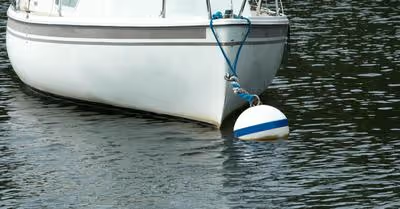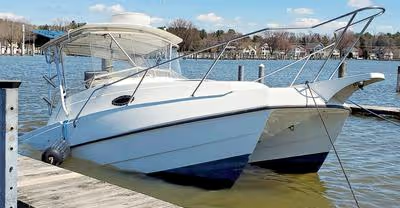Table of Contents
How Winches Work
Winches work by applying friction to the ropes and allowing them to hold them tight in the process. It is ideal if two people work a winch together, especially on a larger boat or in windier conditions.
One person would be tying the rope around the winch while the other person would be in charge or making sure it stays tight, and then they would tighten down the winch. Some winches are different, whereas they have a jaw to thread the rope through.
These devices allow for one person to operate since the rope will not be lost in the jaw and unwind. Some winches you can convert into self-tailing winches, or you can buy them already made.
Operating the Sailboat Winch
Using the sailboat winch is pretty straightforward and should be easy to comprehend after a few times. You will begin by having a rope in one hand and at the bottom of the drum, rotating it in a clockwise motion.
As you begin winding the rope from bottom to top, you will likely use about three of four wraps around. Remember that your rope needs to lay on top of the other and be secured around the drum. Otherwise, you risk the rope pinching down and not having a good resistance.
Once you have wrapped your rope around three or four times around the drum of the winch, remain holding it through the other side and keep tension on it. Then you can insert the winch handle to tighten down the winch and rope.
You will need to cleat or tie off the rope to keep tension on the rope when you have finished this process. Once completed, simply take off the winch handle and put it back in a good storage place.
How to Wrap the Winch
If you are operating the winch for the first time, you might get confused about how you must wrap the drum on the winch. Wrapping it the wrong way will result in fouled lines or a tangled mess.
In most cases, wrapping the line from the bottom to top in a clockwise direction is the proper way to go. Before you wrap the winch, you can give it a turn with your hand to see which direction it will rotate.
Once you have determined the proper direction, then you will confidently know which way to wrap the winch. Whenever the skipper, or if you are sailing by yourself, needs it done, then you will be able to tie it off with ease.
Finishing the Tacking Process
When you have wrapped the rope around the winch, you are ready to tack. This is when you instruct the skipper that it is time to start releasing the sheets.
When the helm is over, the bow will swing through the wind and you can begin releasing the sheets. This means you will need to unwrap the line from the winch and let it run free to the other side.
If the grinder has been preloaded on the other side, then that winch will be ready to help pull in the jib and allow it to switch sides. During this time, the tacking has to be timed correctly.
If you happen to release the winch too early, then the boat will reduce speed and be unable to correctly complete the tack. If you let go of the winch wraps at the wrong time, you risk having your jib getting stuck on the mast or lines, causing a huge mess and potentially turning sharp.
The best thing you can do if you are nervous about the timing of the process is to practice. Have an experienced sailor or someone that is proficient in this process show you how to safely do it. This way you will get a feel for how everything will be and when you need to be releasing the jib sheet.
Practical Uses for Sailboat Winches
Even though winches are designed to be used for their outlined primary purpose, there are some situations where it could come in handy. Regardless if it is an electric or manual, you would be surprised as to the amount of use it provides.
The jib winch helps bring in spring or breast lines on windy days when it does not want to be cooperative at the dock. A couple of wraps on this winch and you can have your vessel wrangled in the dock in no time.
Having a winch on the mast can be useful when hauling halyards or on the stern with spinnaker gear. This could prove to be one of the more useful tools on your boat.
You could also look to secure someone during a man overboard procedure or to tie off your dinghy during hazardous weather. The point here is that you can turn a winch into life saving equipment in a heartbeat with the right plan in mind.
The Appeal of Self-Tailing and Electric Winches
While manual winches are cost-effective, a self-tailing or electric winch is quite appealing if you are by yourself or just do not want the hassle. With advancements in technology, there are plenty of winches to choose from.
Self-tailing winches are designed for the tail to go into a round jam cleat on top of the drum. Once there, you can crank a handle yourself without having to rely on another crew member to pull it for you.
As for an electric winch, this takes it one step further in alleviating the amount of work you have to do. The electric motor will grind the winch automatically while it self-tails, giving you the freedom to raise and lower the jib. This technological advancement will save your back and free up more time.
Caring for Your Winch
As helpful as the winch is designed to be, one wrong move with it and you could easily see $3000 go down the drain. Taking it apart yourself might be a task too difficult for some, but learning how to properly care for it is all you really need.
If you can cover the winch when not in use, like a winch cover, this is an easy step to prolong the life of your winch. With the number of UV rays and salt water splashing about, you can help protect your winches with this easy preventative maintenance method.
In addition, the cover can help protect it from cuts and dings along the way. For something as crucial to the performance of your boat, a simple cover can make a big difference.
Avoiding Accidents
While this operation is fairly simple, there is always room for someone to get hurt. Even though these rarely cause lethal injuries, the risk of losing a finger or severely damaging your hand is possible.
When someone becomes too comfortable around equipment, this is when accidents happen. This is especially true when someone operates the winch and they keep their hands too close to the drum when tightening.
If you are cranking the handle, you definitely do not want to have your hands anywhere near the drum. Always watch your pinch points when operating.
Not only do you have to know what you are doing here, but communication between a crew is crucial to avoiding an accident when using a winch. On larger boats, you might have to have multiple people pulling a rope and tying it off.
If some are cranking while the others are holding the line, both parties have to be aware of their environment to make sure everyone remains safe. In addition, you need to make sure you are holding the line correctly where your thumbs are pointing back toward you. In the event you need to let go of the line, you can do so with ease compared to your fingers being pulled.
Recent Articles

















